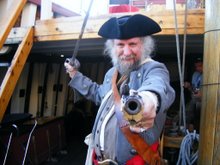I've done that on a smaller scale so I feel qualified to comment on it.
Why did the three masters do so well? They did everything right.Friday, May 2, 2014
Three Against 50
Friday, March 7, 2014
Tricorns
Tricorns are under attack. Some people who claim to be interested in portraying pirates as accurate as possible say that this style hat should not be used and may not have even been around during the GAoP. On the other end, some pre-1840 events have banned "pirate hats" (tricorns).
Someone call Colonial Williamsburg and tell them to stop selling all of those pirate hats.
So, what did pirates wear on their heads?
There are plenty of contemporary woodcuts to use as reference and it's easy to find ones with tricorns.
There are some excceptions
And it's hard to tell quite what Blackbeard is wearing here
Granted that these are mainly captains and might be dressed better Certainly the ones with the whigs were. I looked over a lot more woodcuts and found the most common headgear was either a tricorn, a high, round-crowned hat with an small brim or a cap.
An interesting point here is that the fact that the artists probably never saw the real pirates is a point in favor of them wearing tricorns. The artists were creating images based on descriptions and typical sailors.
Bottom line, pirates wore tricorns.
Someone call Colonial Williamsburg and tell them to stop selling all of those pirate hats.
So, what did pirates wear on their heads?
There are plenty of contemporary woodcuts to use as reference and it's easy to find ones with tricorns.
There are some excceptions
And it's hard to tell quite what Blackbeard is wearing here
Granted that these are mainly captains and might be dressed better Certainly the ones with the whigs were. I looked over a lot more woodcuts and found the most common headgear was either a tricorn, a high, round-crowned hat with an small brim or a cap.
An interesting point here is that the fact that the artists probably never saw the real pirates is a point in favor of them wearing tricorns. The artists were creating images based on descriptions and typical sailors.
Bottom line, pirates wore tricorns.
Subscribe to:
Posts (Atom)



